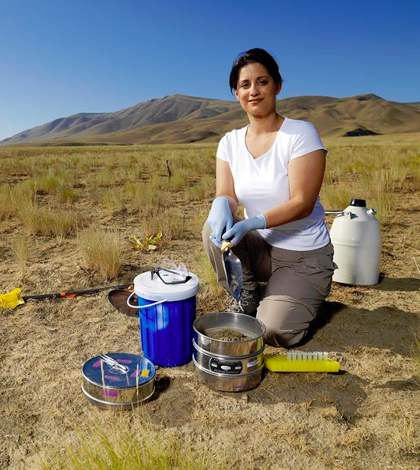Soil Microbes Less Adaptable To Climate Change Than Previously Thought

Vanessa Bailey checks soil samples in 2008 during a nearly two-decade-long analysis of microbial activity in soil. (Credit: PNNL)
Soil microbes are critical for storage of carbon from the atmosphere in the future, helping to mitigate the effects of human greenhouse gas production and global warming.
However, researchers have found that soil microbes might not be as resilient in the face of climate change as previously believed. Rather than adapting quickly to changes in temperature and moisture, transplanted soil microbes in a recent study showed little change even 17 years after being transplanted to different locations on Rattlesnake Mountain in Washington state.
Ben Bond-Lamberty, research scientist at Pacific Northwest National Laboratory (PNNL), was surprised by the results of the study. “We expected more change in the microbial populations over time. Instead, the transplanted microbes seemed to resemble the microbes in their place of origin,” he says. Bond-Lamberty worked with a team of other researchers on the project, notably Vanessa Bailey, a senior research scientist at PNNL.
There were two transplant sites on Rattlesnake Mountain, 500 meters apart vertically. The soil transplants were 30 centimeters across and 30 centimeters deep. Samples of the transplant cores examined in the lab were 3 centimeters wide and 15 centimeters deep. Approximately 72 samples were collected.
Samples originating from the upper, cooler sites tended to have higher respiration rates. Soils moved from the upper to lower sites showed essentially no response to temperature differences.

Soil microbes. (Credit: Alice Dohnalkova / PNNL)
“We found that the microbes respired like the microbes at the original sites, not like the ones surrounding the transplant sites. In other words, the microbes didn’t adapt to the conditions surrounding the transplant areas — they behaved largely as though they had never been moved,” Bond-Lamberty says. “In terms of the genetic data, we didn’t see changes that would suggest adaptive differences.”
All measurements were done on transplanted and native soil samples in incubation chambers in the lab. The respiration, enzymatic activity and genetic makeup of the microbial consortia in the transplanted soils were analyzed. Comparisons were drawn with microbial consortia from the original soil.
Respiration was evaluated using carbon dioxide flow measurements with an EGM-4 infrared gas analyzer. Gas samples were drawn into a chamber, and the amount of scattering of a laser indicated the amount of gas present.
A beta-glucosidase enzyme assay and an n-acetyl-beta-glucosaminidase assay were also performed to indicate general activity levels of the microbes. Temperature was controlled to mimic the outdoor conditions for the soil sample being examined. Moisture was evaluated by weighing the sample core, drying it, and subtracting the weight. Density was calculated simply using mass over volume.
Genetic sequence data for the soil bacteria were obtained through an Illumina MiSeq targeting 16S ribosomal RNA.

Transplanted soil, lush with microbes. (Credit: PNNL)
Lab incubation conditions for the soil were designed to mimic the temperature flux the microbes might experience in their positions on Rattlesnake Mountain. Two different temperature and moisture environments were simulated depending on elevation. Characteristic mean monthly maximum temperatures ranged from 23 degrees Celsius at the higher elevation, up to 28 degrees Celsius at the lower elevation. Samples were held in lab incubators for 100 days.
“We didn’t attempt to get the genus and species names of the soil microbes,” says Bond-Lamberty. “The bacteria, fungus and plants created such a complex population we didn’t attempt to identify them all. We were just interested in population changes, and we could get a perspective on that with the 16S information plus the other data. We only sequenced the bacteria. Fungi are important, but more difficult to sequence thoroughly.”
The project was unique in that it was the first one to look at transplanted soil microbial species’ adaptations to climate change over an unusually long period, 17 years. It is believed to be the longest soil-transplant experiment ever performed.
Bond-Lamberty, his co-author Vanessa Bailey and their team are working to figure out why the microbes did not adapt as much or as quickly as anticipated.
“Soil accumulates over thousands of years. Maybe the microbes were already highly adapted to their original environments over a much longer time than 17 years. Maybe if the study were continued for a much longer time, changes would become more apparent,” Bond-Lamberty muses. “Honestly, we don’t have a good answer to that question yet.”
Work at the Rattlesnake Mountain site may continue at some point in the future, with the team possibly conducting follow-up work looking at other greenhouse gases besides carbon dioxide, like nitrous oxide and methane. The team has also considered probing the physical and chemical structures of the area’s soil.
“Our current generation of climate models does not account for slow microbe adaptability effects on climate change on ecosystems. We don’t know the magnitude of the effect of microbes possibly becoming less effective at storing carbon as the climate continues to change,” says Bond-Lamberty. “We are continuing to study the issue, but it could be very significant.”
Top image: Vanessa Bailey checks soil samples in 2008 during a nearly two-decade-long analysis of microbial activity in soil. (Credit: PNNL)




0 comments